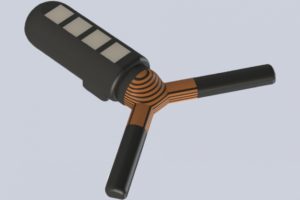

Ingestible Bluetooth capsule
In a major breakthrough, researchers at MIT, alongside Draper and women’s college have developed an ingestible Bluetooth capsule. The new capsule can be controlled wirelessly to deliver the drugs on demand by simply giving smartphone commands. The new device has broad applications and would be very handy to deliver drugs in cases of HIV and malaria that warrant strict dosing regimens. The new capsule can stay in the stomach for about a month and can respond as per the instructions from the smartphone.


For the new capsule, the researchers took inspiration from the earlier one developed in 2016 and combined many of the features into the existing one. The early capsule comprised six arms which are folded and encapsulated in a gelatin shell. Once ingested the arms would open up, hence preventing the capsule from getting released from the stomach. Each arm is composed of four compartments loaded with drugs and medications. After the complete exhaustion of the drugs, the biodegradable core dissolves thereby closing the arms. The capsule then passes through the digestive tract and can be excreted.
Similar to the model, the new capsule feature only two arms with four compartments that would be Y-shaped when open. For the exact representation of the architecture, researchers used 3D technology to print the capsule. It facilitated them to incorporate all components of the capsule composed of alternating compartments of stiff and flexible layers. The arrangement helps to overcome the acidic environment in the stomach. The researchers initially tested the capsule in pigs with a sensor to monitor body the temperature. The capsule was able to transmit the data wirelessly using Bluetooth technology when the smartphone is placed at arm’s length near the pig.
Also Read: Buddy smart life-collar saves your child from accidental drowning
The researchers believe the new device can be used for early detection of the onset of infections or allergic reactions and respond accordingly. For instance, it can be ordered to release antibiotics in case of infections and anti-histamines in response to allergic reactions. The ingestible Bluetooth capsule is powered by silver oxide and now the team is looking to power it by alternate means such as the external antennae or the stomach acid.
The research is being led by Professor Robert Langer (MIT)and Dr Giovanni Travesso (Women’s college) and published in the Journal “Advanced Materials Technologies”
iEV motors from Denmark has manufactured a pod-sized 78 cm iEV Z modular electric car.…
Garena free fire - Illuminate is a multiplayer battle royal mobile game. The app is…
The stressors of adult life can take a serious toll on your brain and make…
Men often experience a lot of irritation and embarrassment due to the unwanted growth of…
Web application architecture describes the relationship between servers, databases and applications. All web applications are…
Gone are the days when mobile phones come in handy only for voice calling and…